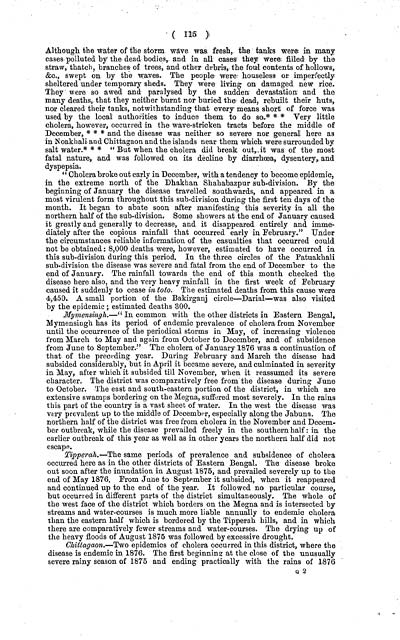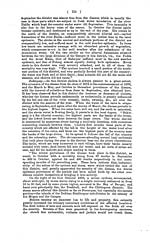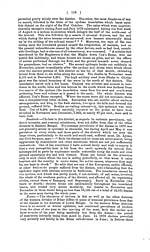Medicine - Disease > Cholera in India, 1862 to 1881
(155) Page 115
Download files
Individual page:
Thumbnail gallery: Grid view | List view

(115)
Although the water of the storm wave was fresh, the tanks were in many
cases polluted by the dead bodies, and in all cases they were filled by the
straw, thatch, branches of trees, and other debris, the foul contents of hollows,
&c., swept on by the waves. The people were houseless or imperfectly
sheltered under temporary sheds. They were living on damaged new rice.
They were so awed and paralysed by the sudden devastation and the
many deaths, that they neither burnt nor buried the dead, rebuilt their huts,
nor cleared their tanks, notwithstanding that every means short of force was
used by the local authorities to induce them to do so.* * * Very little
cholera, however, occurred in the wave-stricken tracts before the middle of
December, * * * and the disease was neither so severe nor general here as
in Noakhali and Chittagaon and the islands near them which were surrounded by
salt water.* * * "But when the cholera did break out, it was of the most
fatal nature, and was followed on its decline by diarrhoea, dysentery, and
dyspepsia.
"Cholera broke out early in December, with a tendency to become epidemic,
in the extreme north of the Dhakhan Shahabazpur sub-division. By the
beginning of January the disease travelled southwards, and appeared in a
most virulent form throughout this sub-division during the first ten days of the
month. It began to abate soon after manifesting this severity in all the
northern half of the sub-division. Some showers at the end of January caused
it greatly and generally to decrease, and it disappeared entirely and imme-
diately after the copious rainfall that occurred early in February." Under
the circumstances reliable information of the casualties that occurred could
not be obtained: 8,000 deaths were, however, estimated to have occurred in
this sub-division during this period. In the three circles of the Patuakhali
sub-division the disease was severe and fatal from the end of December to the
end of January. The rainfall towards the end of this month checked the
disease here also, and the very heavy rainfall in the first week of February
caused it suddenly to cease in toto. The estimated deaths from this cause were
4,450. A small portion of the Bakirganj circle-Darial-was also visited
by the epidemic; estimated deaths 300.
Mymensingh.-" In common with the other districts in Eastern Bengal,
Mymensingh has its period of endemic prevalence of cholera from November
until the occurrence of the periodical storms in May, of increasing violence
from March to May and again from October to December, and of subsidence
from June to September." The cholera of January 1876 was a continuation of
that of the preceding year. During February and March the disease had
subsided considerably, but in April it became severe, and culminated in severity
in May, after which it subsided till November, when it reassumed its severe
character. The district was comparatively free from the disease during June
to October. The east and south-eastern portion of the district, in which are
extensive swamps bordering on the Megna, suffered most severely. In the rains
this part of the country is a vast sheet of water. In the west the disease was
very prevalent up to the middle of December, especially along the Jabuna. The
northern half of the district was free from cholera in the November and Decem-
ber outbreak, while the disease prevailed freely in the southern half: in the
earlier outbreak of this year as well as in other years the northern half did not
escape.
Tipperah.-The same periods of prevalence and subsidence of cholera
occurred here as in the other districts of Eastern Bengal. The disease broke
out soon after the inundation in August 1875, and prevailed severely up to the
end of May 1876. From June to September it subsided, when it reappeared
and continued up to the end of the year. It followed no particular course,
but occurred in different parts of the district simultaneously. The whole of
the west face of the district which borders on the Megna and is intersected by
streams and water-courses is much more liable annually to endemic cholera
than the eastern half which is bordered by the Tipperah hills, and in which
there are comparatively fewer streams and water-courses. The drying up of
the heavy floods of August 1875 was followed by excessive drought.
Chittagaon.-Two epidemics of cholera occurred in this district, where the
disease is endemic in 1876. The first beginning at the close of the unusually
severe rainy season of 1875 and ending practically with the rains of 1876
Q 2
Although the water of the storm wave was fresh, the tanks were in many
cases polluted by the dead bodies, and in all cases they were filled by the
straw, thatch, branches of trees, and other debris, the foul contents of hollows,
&c., swept on by the waves. The people were houseless or imperfectly
sheltered under temporary sheds. They were living on damaged new rice.
They were so awed and paralysed by the sudden devastation and the
many deaths, that they neither burnt nor buried the dead, rebuilt their huts,
nor cleared their tanks, notwithstanding that every means short of force was
used by the local authorities to induce them to do so.* * * Very little
cholera, however, occurred in the wave-stricken tracts before the middle of
December, * * * and the disease was neither so severe nor general here as
in Noakhali and Chittagaon and the islands near them which were surrounded by
salt water.* * * "But when the cholera did break out, it was of the most
fatal nature, and was followed on its decline by diarrhoea, dysentery, and
dyspepsia.
"Cholera broke out early in December, with a tendency to become epidemic,
in the extreme north of the Dhakhan Shahabazpur sub-division. By the
beginning of January the disease travelled southwards, and appeared in a
most virulent form throughout this sub-division during the first ten days of the
month. It began to abate soon after manifesting this severity in all the
northern half of the sub-division. Some showers at the end of January caused
it greatly and generally to decrease, and it disappeared entirely and imme-
diately after the copious rainfall that occurred early in February." Under
the circumstances reliable information of the casualties that occurred could
not be obtained: 8,000 deaths were, however, estimated to have occurred in
this sub-division during this period. In the three circles of the Patuakhali
sub-division the disease was severe and fatal from the end of December to the
end of January. The rainfall towards the end of this month checked the
disease here also, and the very heavy rainfall in the first week of February
caused it suddenly to cease in toto. The estimated deaths from this cause were
4,450. A small portion of the Bakirganj circle-Darial-was also visited
by the epidemic; estimated deaths 300.
Mymensingh.-" In common with the other districts in Eastern Bengal,
Mymensingh has its period of endemic prevalence of cholera from November
until the occurrence of the periodical storms in May, of increasing violence
from March to May and again from October to December, and of subsidence
from June to September." The cholera of January 1876 was a continuation of
that of the preceding year. During February and March the disease had
subsided considerably, but in April it became severe, and culminated in severity
in May, after which it subsided till November, when it reassumed its severe
character. The district was comparatively free from the disease during June
to October. The east and south-eastern portion of the district, in which are
extensive swamps bordering on the Megna, suffered most severely. In the rains
this part of the country is a vast sheet of water. In the west the disease was
very prevalent up to the middle of December, especially along the Jabuna. The
northern half of the district was free from cholera in the November and Decem-
ber outbreak, while the disease prevailed freely in the southern half: in the
earlier outbreak of this year as well as in other years the northern half did not
escape.
Tipperah.-The same periods of prevalence and subsidence of cholera
occurred here as in the other districts of Eastern Bengal. The disease broke
out soon after the inundation in August 1875, and prevailed severely up to the
end of May 1876. From June to September it subsided, when it reappeared
and continued up to the end of the year. It followed no particular course,
but occurred in different parts of the district simultaneously. The whole of
the west face of the district which borders on the Megna and is intersected by
streams and water-courses is much more liable annually to endemic cholera
than the eastern half which is bordered by the Tipperah hills, and in which
there are comparatively fewer streams and water-courses. The drying up of
the heavy floods of August 1875 was followed by excessive drought.
Chittagaon.-Two epidemics of cholera occurred in this district, where the
disease is endemic in 1876. The first beginning at the close of the unusually
severe rainy season of 1875 and ending practically with the rains of 1876
Q 2
Set display mode to: Large image | Zoom image | Transcription
Images and transcriptions on this page, including medium image downloads, may be used under the Creative Commons Attribution 4.0 International Licence unless otherwise stated. ![]()
| India Papers > Medicine - Disease > Cholera in India, 1862 to 1881 > (155) Page 115 |
|---|
| Permanent URL | https://digital.nls.uk/74533878 |
|---|




